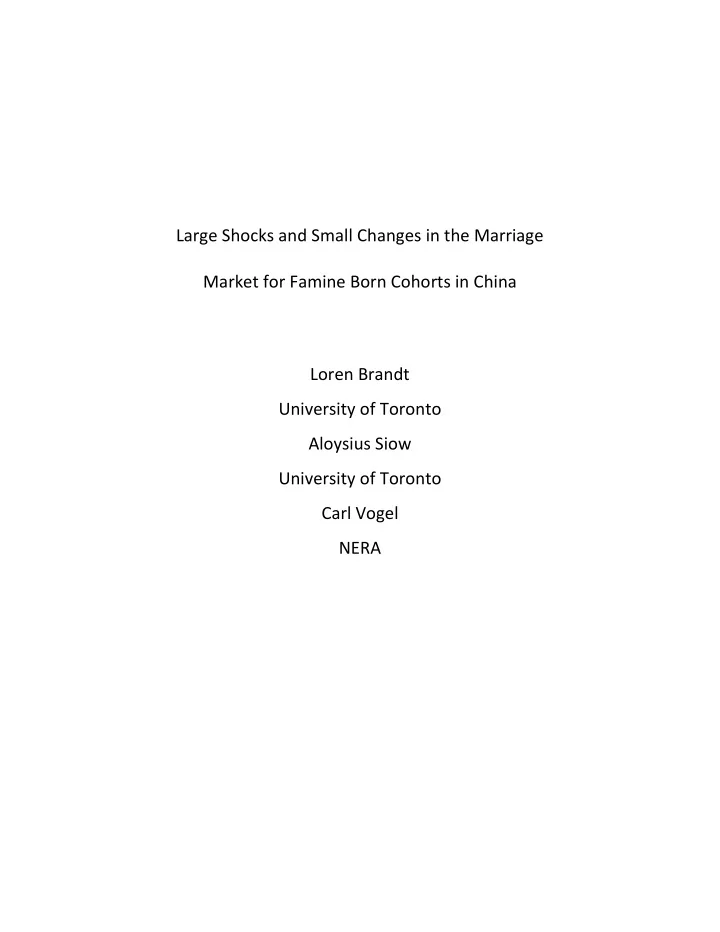

Large Shocks and Small Changes in the Marriage Market for Famine Born Cohorts in China Loren Brandt University of Toronto Aloysius Siow University of Toronto Carl Vogel NERA
The “Great Leap Forward” was a national -level political and economic experiment in China between 1959 and 1961. It resulted in the most severe famine in China in the 20 th century. Estimates of famine-related mortality range from 15 to 30 million deaths; births lost or postponed resulted in about 25 million fewer births. In general, the countryside was struck much harder than cities. The economic experiment was abandoned by early 1962. The mortality rate quickly fell and the birth rate also quickly recovered.
What were the marital outcomes of famine-affected cohorts? o Likelihood of marriage? o Who married whom? o Gains from marriage? Complicated quantity and quality effects 1. Famine-born cohorts should enjoy an increase in their scarcity values in the marriage market 2. Relative scarcity in the labor market should increase their wages, and therefore their marital attractiveness. 3. Bad health effects to famine-born cohort reduced their labor and marital attractiveness 4. Survival of pre-famine cohort impl ies “fitter” cohort Heterogeneous treatments on cohorts linked through general equilibrium Regression Methods: Almond et. al (2008), Porter (2010) o Cannot deal with general equilibrium effects o Collinearity of quantity and adverse health shocks
Paper presents two kinds of estimates 1. Non-parametric reduced form estimates of total effects of the famine on the affected cohorts - No functional form assumptions - Includes all general equilibrium effects - Estimator is a first differenced estimator in “total gains” - Consistency depends on suitable choice of treatment and control 2. Use reduced form estimates to estimate Choo-Siow, a non-parametric structural model of the marriage market - Use CS to decompose total effects into quantity and quality effects - Quality estimates based on residual accounting - Consistency is model dependent
Data: Population Census, 1982, 1990, and 2000 Focus on Rural Sichuan and Anhui Only discuss Sichuan here Strategy: Compare marital behaviour of famine-affected cohorts in 1990 to their same age peers in 1982 In 1990, the post-famine cohort was 26-28. Most women of 26 and older would have acquired their permanent marital status. Except for 26 and 27 year olds, also true for men. The pre and post famine born cohorts were between 32-
Quantity versus Quality 1. Use Choo-Siow to decompose changes in total gains to those arising from changes in relative scarcity (surplus) versus relative quality 2. To a first order, simultaneous changes in quantities and qualities cancel each other out, resulting in small changes in marriage rates
3. Exercise points to significant reduction in marital attractiveness relating to changes in health or education 4. Adding educational attainment to capture human capital endowments cannot explain changes in total gains 5. Other health-related outcomes important; our total gains measure in fact predicts post-marital outcomes, notably, fertility
External Validity of Choo-Siow
Conclusions 1. Benefits famine-born cohorts derived from relative scarcity offset by their decline in marital attractiveness 2. Methodologically, allowing for general equilibrium effects and estimating heterogeneous treatment effects are important b/c pre-famine, famine-born, and post-famine born cohorts experienced very different but linked outcomes. 3. We are able to provide external validity of the Choo-Siow measure of total gains as a measure of marital output: Variations in total gains between the two census predict variations in future childlessness of these marital matches.
Recommend
More recommend